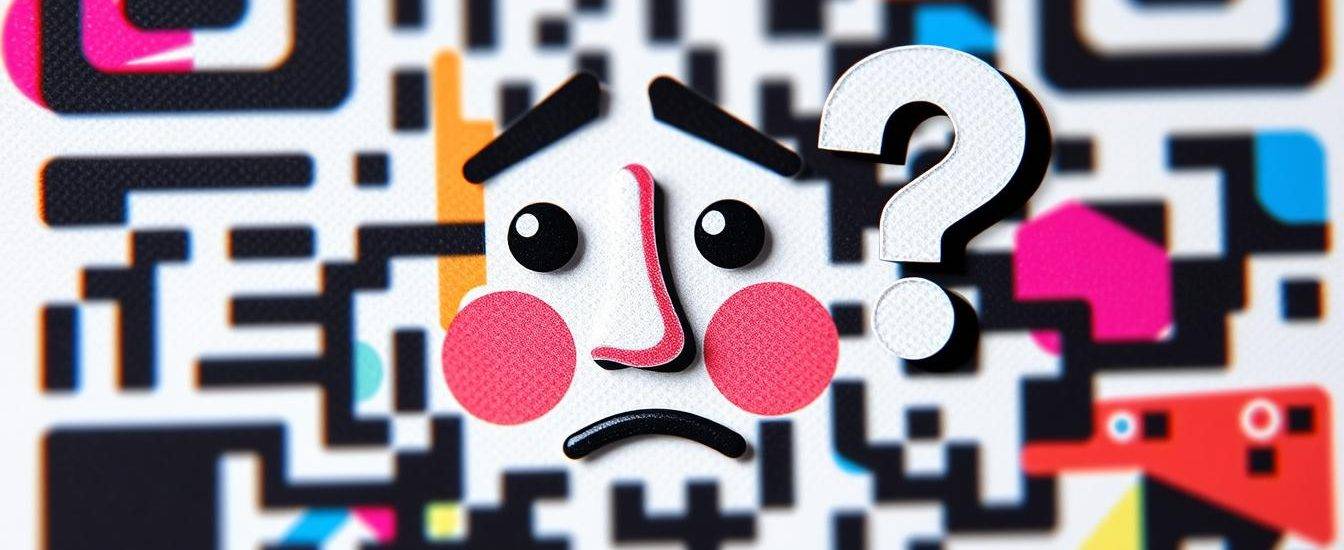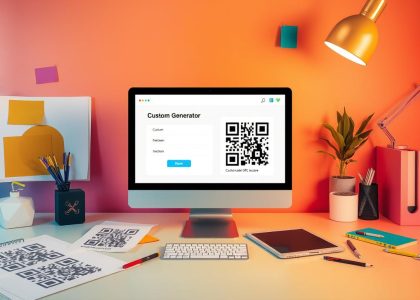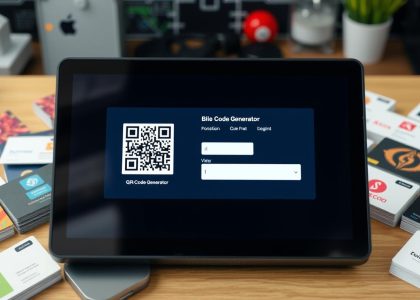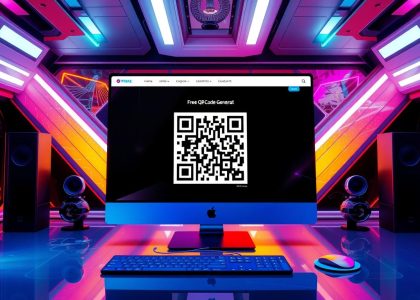In today’s digital world, QR codes are everywhere. They connect the physical and virtual worlds easily. You might think you need a generator to make QR codes, but you can actually create them from scratch. This guide will show you how to make a QR code without a generator. You’ll learn to design and create custom QR codes for your needs.
Key Takeaways
- Discover the versatility of creating custom QR codes without relying on generators
- Learn the fundamentals of QR code structure and encoding to design your own
- Explore techniques to incorporate branding and logos into your handmade QR codes
- Understand the importance of testing and verifying your QR codes for optimal performance
- Gain insights into the security considerations and creative use cases for custom QR codes
Introduction to QR Codes
In today’s digital world, QR codes are everywhere, changing how we get information. But what are QR codes, and why should you make your own?
What are QR codes?
QR codes, or Quick Response codes, are two-dimensional barcodes that hold lots of info. They can be scanned with a smartphone camera, giving quick access to websites, contacts, and more. They’re a big help for businesses and people, making digital content easy to find.
Benefits of creating custom QR codes
Making your own qr code has many benefits. You can design a qr code that matches your brand, making it more memorable for your audience. Custom qr codes let you control the content, making sure it meets your needs.
Also, manual qr code design lets you add your brand and images. This makes your qr code look better and more recognizable. It can also get more people to interact with it.
“QR codes have transformed the way we access information, blending the physical and digital worlds with remarkable ease.”
Prerequisites for Creating QR Codes Manually
Creating a QR code without a generator might seem hard. But, with the right tools and resources, it’s easy. To start making QR codes by hand, you’ll need a few key items.
First, you need to know how QR codes work. This means understanding the different types of encoding, character sets, and error correction levels. Knowing this will help you design and encode your QR code correctly.
To make DIY QR codes, you’ll need a vector graphics editor like Adobe Illustrator or Inkscape. These tools let you create the QR code matrix and add logos, colors, or other designs. You might also need a code generation tool or script for encoding.
For printing your QR code, you’ll need a high-quality printer. The QR code must be clear, sharp, and easy to scan. So, using the right printing materials and techniques is crucial.
- Vector graphics editor (e.g., Adobe Illustrator, Inkscape)
- QR code generation tool or script
- High-quality printer
- Understanding of QR code structure and encoding
With these requirements for manual qr code creation, you’re ready to make custom QR codes. Remember, paying attention to detail and understanding QR code technology are important for success.
Understanding QR Code Structure
To make QR codes by hand, knowing their structure is key. QR codes are two-dimensional barcodes that hold a lot of data in a small space. They have parts like encoding modes, character sets, and error correction levels.
Encoding Modes and Character Sets
QR codes can hold different kinds of data, like text, URLs, and contact info. The encoding mode shows how the data is stored in the QR code. The main modes are:
- Numeric – for numbers
- Alphanumeric – for letters and numbers
- Byte – for binary data, like special symbols
- Kanji – for Japanese Kanji characters
Choosing the right encoding mode is important for manual QR code design. It makes sure the data is encoded correctly.
Error Correction Levels
QR codes can still be read even if they’re damaged. They have four error correction levels:
- Low – up to 7% damage
- Medium – up to 15% damage
- Quartile – up to 25% damage
- High – up to 30% damage
The higher the error correction, the more space the QR code needs. When designing a QR code, picking the right error correction level is key.
| Encoding Mode | Characters Supported |
|---|---|
| Numeric | 0-9 |
| Alphanumeric | 0-9, A-Z, space, $, %, *, +, -, ., /, : |
| Byte | All 8-bit byte characters (0x00-0xFF) |
| Kanji | Kanji characters |
Knowing about qr code structure, qr code encoding, qr code character sets, and qr code error correction is vital for manual QR code design. This knowledge helps you create custom QR codes that work as needed.
how to make a qr code without a generator
Making a QR code without a generator is easy and lets you customize it. We’ll show you how to do it manually. This way, you can control your digital content and branding.
Step 1: Determine the Data to Encode
First, decide what info you want to put in your QR code. It could be a website URL, contact info, or event details. Keep it short and simple for easy scanning.
Step 2: Choose an Encoding Mode and Character Set
QR codes can hold different types of data. Pick the right encoding mode and character set for your content. This makes sure your QR code works well.
Step 3: Determine the Error Correction Level
QR codes can handle errors, but you need to choose how much. Pick a level that balances code size and reliability.
Step 4: Generate the QR Code Matrix
With your data and settings ready, create the QR code matrix. This turns your info into a scannable grid of black and white squares.
Step 5: Finalize the Design
After making the matrix, add your branding and design touches. This makes your QR code unique and eye-catching.
By following these steps, you can make a custom QR code without a generator. It takes some effort, but you get a unique QR code that fits your needs perfectly.
Designing the QR Code Layout
Making a great QR code is more than just creating it. The design and layout are key to making it look good and work well. We’ll look at important parts of designing your QR code layout, like where to put the finder patterns and how to encode the data.
Positioning the Finder Patterns
The three square finder patterns in a QR code’s corners are essential for scanners. They help the scanner find the code’s orientation and position. It’s important to place these finder patterns well for a qr code layout design that looks good and works well.
Make sure they are easy to see and evenly spaced. This will make your QR code look balanced and attractive.
Encoding Data into the Matrix
The data in a QR code is its core. It’s important to encode the data well for both looks and function. Pick the right qr code data encoding method for your information. Try different designs and patterns to find the best way to show your data.
Learning about qr code finder patterns and data encoding helps you make custom QR codes. They should be both useful and eye-catching. Spend time on a design that combines these elements well. This way, your QR code will grab attention and share your message effectively.
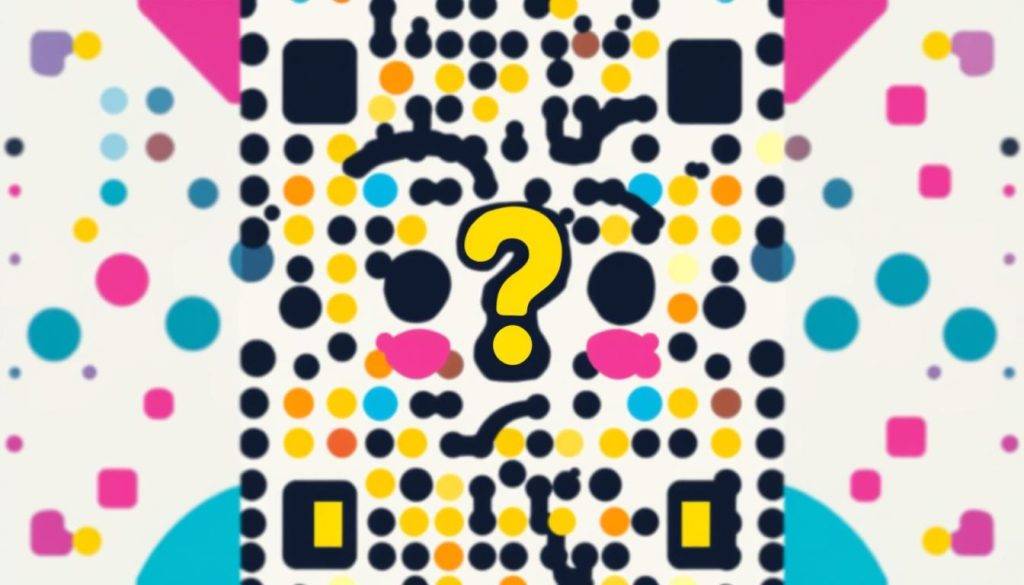
Adding Logos and Branding
Making a custom QR code is more than just putting data in it. It’s a chance to add your brand’s look to the design. You can mix in your logo, colors, and other brand stuff. This makes your QR code not only useful but also nice to look at and easy to spot.
Getting your branding QR code right means finding a balance. You need to make sure it looks good and works well. Your goal is to make a design that grabs attention and is easy to scan. This way, your customers can quickly find what you’ve shared.
Integrating Your Logo
Putting your logo in a QR code is a smart move. You can place it in the middle or inside the code. But, make sure it doesn’t mess up the code’s look or how it works.
- Adjust the logo size and where it goes to keep the QR code working right.
- Choose colors that make your logo and the QR code stand out.
- Try different layouts to find the best one for your brand.
Customizing the Color Scheme
Changing the colors in your QR code is another way to show your brand. Pick colors that match your brand and make sure the QR code and background contrast well.
“The right mix of branding and function can make a simple QR code a strong tool for connecting with customers and getting them to your content.”
By making a custom QR code that fits your brand’s look, you can make a lasting impression. This can help make your brand more known and loved.
Testing and Verifying Your QR Code
Creating a captivating QR code is just the first step. To ensure your QR code functions flawlessly, it’s crucial to thoroughly test and verify it before deploying it. This step is essential for qr code quality assurance and enhancing the user experience.
Start by scanning your QR code using various mobile devices and QR code scanning apps. This allows you to confirm that the code is readable and redirects users to the intended destination, whether it’s a website, a contact card, or any other content.
- Ensure the QR code is properly encoded and the data is accurate.
- Check that the qr code verification process is seamless, with no errors or redirects.
- Evaluate the qr code scanning experience, making sure it’s intuitive and user-friendly.
In addition to testing the functionality, consider the visual aspects of your QR code. Verify that the size, contrast, and overall design are optimized for easy scanning and recognition. This attention to detail will enhance the qr code testing process and contribute to a positive user experience.
“Thoroughly testing your QR code is the key to ensuring a flawless user experience and maximizing the impact of your QR code marketing efforts.”
By following these steps, you can confidently deploy your QR code, knowing that it will provide a seamless and enjoyable experience for your audience. Remember, qr code quality assurance is an essential part of the QR code creation process, so don’t skip this crucial step.
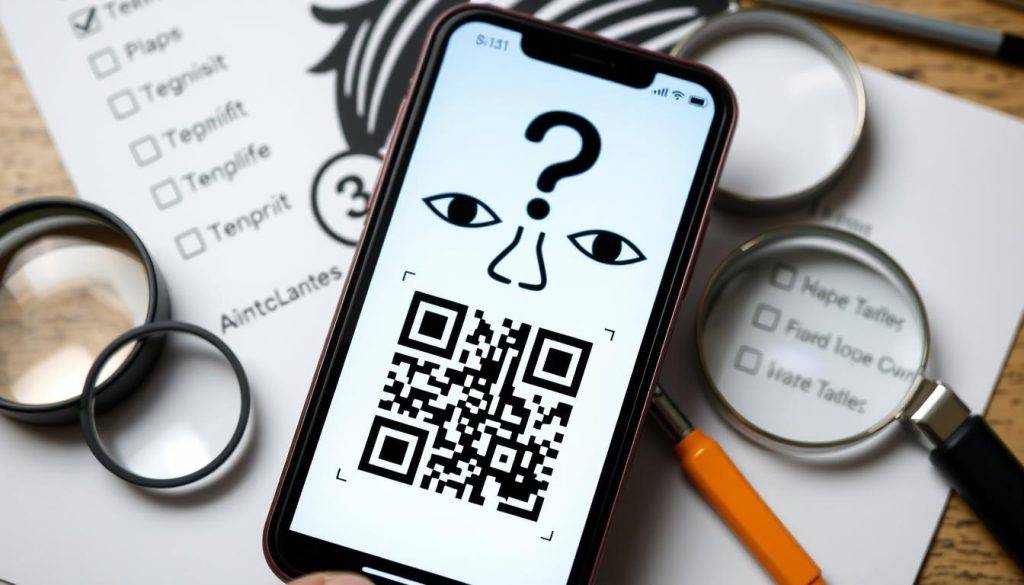
Common Pitfalls and Troubleshooting
Ensuring Proper Scaling and Print Quality
Creating a QR code manually requires careful attention to scaling and print quality. This ensures a smooth scanning experience. Troubleshooting and fixing qr code issues can be a challenge, but it’s possible with the right steps.
The size of the QR code is key. It should be big enough to scan easily but not too big. A good size is at least 2 inches (5 cm) square and no more than 4 inches (10 cm) square.
Print quality is also crucial. The QR code needs to be printed with high-quality, high-contrast ink. This ensures it scans well. Avoid low-quality prints or materials that might distort the QR code.
Before finalizing your design, test the QR code thoroughly. Scan it with different devices and in various lighting. This checks if it’s readable and reliable.
“By addressing common qr code scaling and print quality issues, you can create a QR code that is both visually stunning and highly functional.”
With careful attention and testing, you can avoid common problems. This way, you’ll get the results you want from your manual QR code creation.
Creative Use Cases for Custom QR Codes
Discover the full potential of QR codes. They offer more than just traditional uses. Explore unique opportunities for both personal and professional growth.
Get creative with personalized QR code uses. Use them in wedding invites, graduation cards, or holiday greetings. They can also spice up scavenger hunts, event programs, or art installations.
Businesses can use unique QR code applications to engage customers. Add QR codes to product packaging, business cards, or employee badges. This can lead to more online interactions and brand recognition.
| Creative QR Code Ideas | Unique QR Code Applications | Personalized QR Code Uses |
|---|---|---|
| Interactive art installations | Product packaging | Wedding invitations |
| Scavenger hunt integration | Business cards | Graduation announcements |
| Event program elements | Employee badges | Holiday cards |
Let QR codes unleash your creativity. Dive into creative QR code ideas, unique QR code applications, and personalized QR code uses. They can captivate your audience and enhance your work or personal projects.
“The only limit to the power of a QR code is the limits of your own imagination.”
QR Code Security Considerations
QR codes are getting more popular, but we need to talk about their security and privacy. When you make QR codes by hand, it’s key to keep the data safe from misuse.
One big thing to think about is data protection. QR codes can hold everything from simple links to personal or financial info. It’s vital to encrypt this data, especially when you’re making QR codes yourself.
Mitigating Risks of QR Code Misuse
- Avoid encoding sensitive information: Don’t put personal details, financial data, or confidential info in your QR code.
- Implement encryption: Use strong encryption to keep the QR code data safe, even if someone scans it without permission.
- Limit accessibility: Only share your QR code with people you trust or in places you control to avoid unauthorized access.
Enhancing QR Code Privacy
Privacy is also a big deal with QR codes. When you make them by hand, think about how they might track or watch people.
| Privacy Measure | Description |
|---|---|
| Anonymize User Data | Make sure your QR code doesn’t collect or share personal info without asking the user first. |
| Implement Consent Mechanisms | Be clear with users about what your QR code does and ask for their okay before using their data. |
| Respect User Control | Let users choose not to be tracked or have their data collected, and let them control their privacy settings. |
By focusing on qr code security and privacy, you can make QR codes that are useful and safe for everyone.
Conclusion
In this guide, we’ve delved into making QR codes by hand. You now know how to create your own custom QR codes. These can be used in marketing, personal projects, or any other need for a unique QR code.
Key points include manually encoding data and adding logos. We also talked about testing and fixing QR codes to make sure they work well and look good.
Now, it’s time to get creative with QR codes. Think of new ways to use them, like on business cards or at events. Learning to make QR codes yourself gives you more control and flexibility. You can make them fit your exact needs and goals.


